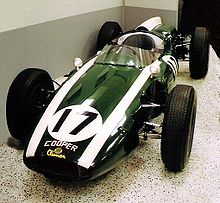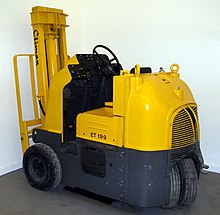Coventry Climax

Coventry Climax was a British manufacturer of forklifts , fire pumps, and specialty and racing engines.
history
In 1903, Pelham Lee , who had previously worked for the Daimler Motor Company , an internal combustion engine company, founded Lee-Stroyer . Originally in partnership with Mr. Stroyer, who left in 1905. Lee now ran the small company alone and moved to Paynes Lane in Coventry . He now called the company Coventry-Simplex . One of the first customers was the GWK company , which fitted over 1,000 cars with the two-cylinder engines from 1911 to 1915. Just before World War I, Lionel Martin used a Coventry-Simplex engine for the first Aston Martin . Even Ernest Shackleton used these motors to drive the tractors in its first Antarctic expedition from 1914 to 1917.
During the First World War, hundreds of the motors were used as generators for searchlights. In 1917 the company moved to East Street and changed the name to Coventry Climax . In the 1920s the company moved to Friars Road . At the end of the 1930s business was doing well and the former Riley property on Widdrington Road was bought .
During the 1920s and 1930s, many small car manufacturers were Coventry Climax customers:
At the beginning of the 1930s even buses were equipped with the engines.
When Swift closed in 1931, Climax got stuck on loads of engines. These were converted into power generators, which opened up a completely new field of business for the company. This also led to the development of fire pumps. The “Godiva” type in particular was used a lot during the Second World War.
After the Second World War
After the Second World War, new customers came:
In the late 1940's, the company shifted its focus from automotive engines to other markets. Diesel engines for the navy, pumps and forklifts were developed. In 1946, the first British forklift truck was introduced with the ET199 . It could lift (4000 lb) (9 ft) high. Walter Hassan , formerly with Jaguar and Bentley , came to Coventry-Climax in 1950 . In the same year the FW engine (FW stands for Feather Weight ) was introduced, an engine with an overhead camshaft. With the experience gained from car engines and ship engines, the H30 diesel engine was developed, a multi-function engine for the military sector. It was used in the Chieftain and Challenger 1 main battle tanks as an auxiliary engine, as well as for the Rapier air defense system.
In 1963 the company was bought by Jaguar , but in 1966 they merged with the British Motor Corporation (BMC) to form British Motor Holdings (BMH). BMH, in turn, was merged with Leyland Motors in 1968 to form the British Leyland Motor Corporation . It was nationalized as British Leyland (BL) in 1975 . Coventry Climax has now become part of British Leyland's Specialty Products division , along with well-known names such as Alvis Vickers Ltd , Aveling-Barford and a few others. At the end of 1978, BL founded BL Commercial Vehicles (BLCV) from Coventry Climax Limited (engines), Leyland Vehicles Limited (trucks, buses and tractors), Alvis Limited (military vehicles) and Self-Changing Gears Limited (gearboxes), with David Abell as Director.
As early as the early 1970s, the fire pump division was sold to investors who founded Godiva Fire Pumps in Warwick . In 1977 Coventry Climax bought the forklift division of Rubery Owen Conveyancer and was now called Climax Conveyancer. In 1982, BL sold the forklift division of Coventry Climax to a private investor, Coventry Climax Holdings Limited . Sir Emmanuel Kaye, chairman and largest shareholder of Lansing Bagnall , founded the company to take over Coventry Climax.
In 1986 Coventry Climax went bankrupt and was bought by Cronin Tubular . The next owner came in 1990 with Horstman Defense Systems from Bath , who bought the engine division. This was the first time the company left Coventry. The forklift division was bought by Kalmar Industries (part of Cargotec ) in the late 1980s , which then renamed itself Kalmar Climax .
Engines
Type OC and JM
The type OC was a 1122 cm³ 4-cylinder in- line engine with a bore of 63 mm and a piston stroke of 90 mm, with overhead intake and side exhaust valves it produced 34 hp. It came on the market in the early 1930s. A license to build was also given to Triumph . The six-cylinder version JM with 1476 cm³ developed 42 hp.
The FW series
The type FW had a displacement of 1020 cm³ and delivered 38 hp. The designers Walter Hassan and Harry Mundy designed the motor for mobile fire service pumps.
FWA
In 1953 it was converted for racing cars. The racing version FWA had 71 hp / 1097 cm³. The first use was at Kieft in Le Mans in 1954.
FWB
The FWB version had a larger bore and more stroke and so came to 1460 cm³ and 108 hp.
FWE
The most important development was the FWE version , a combination of the bore of the FWB and the stroke of the FWA . Actually only built for the Lotus Elite , it became a favorite of many racing teams. It was also available on TVR Grantura .
FWMA
The FWMA was the successor model to the FWC and was based on the FWM model of the Navy. The FWMA car version was not very successful at Lotus , but it was redesigned by Rootes and became a lightweight engine for the Hillman Imp . Bearcat also built FWB -based outboard engines in the USA . The Lotus cars with Climax engines won several awards for best performance at the Le Mans 24-hour races .
FPF
The FPF version was a pure race development, a version with two overhead camshafts ( DOHC ) based on the FWB design. It started as a 1.5 liter for Formula 2 and slowly developed into the 2.0 liter engine for Formula 1 . From 1957 to 1960 it was the dominant engine in Formula 2. With this engine, Stirling Moss and Maurice Trintignant won their first two Grand Prix victories for Cooper against the 2.5 liter competition. Later the engine also grew to the permitted 2.5 liters for Formula 1 and 2.7 liters for the Indy and Tasman series . In 1966 a 3.0 liter version was even used in Formula 1.
FWMV
Another special version, developed from the marine version, was the FWMV , a 90 ° V eight-cylinder engine with an initial crossplane - and later flatplane crankshaft design and 1.5 liter displacement. It initially produced 174 hp, later over 200 hp and was used in a number of Lotus racing cars, including: Lotus 24 , Lotus 25 and Lotus 33 . These cars won the Jim Clark , the Formula 1 season in 1963 and the Formula 1 1965 season .
At Cooper , the engine was found in the Formula Junior Cooper T51-Climax .
FPE ("Godiva")
Climax built two remarkable engines, but they never saw a race. The first version was the V8 FPE ("Godiva"), it was intended for the Formula 1 season in 1954, but was allegedly withdrawn for fear of Mercedes. Paul Emery bought a Godiva and installed it after increasing the displacement to 3.0 liters in the Shannon SH-1 racing car , which contested a Formula 1 race under Trevor Taylor in 1966 . The machine also worked in a slightly different form in the Kieft Grand Prix car .
Flat-16 FWMW
Another engine never used was the flat-16 FWNW . Work on this was done with Lotus and Brabham during the final years of the Formula 1.5L, but a number of problems persisted when the racing series ended. At this point the engine had shown little more than the familiar V8s, and the problems actually called for a complete redesign of the design. The engine did reach higher speeds, but the torque was lower and the consumption and weight were higher. This ultimately meant the end for this engine.
List of Formula 1 engines
| Year _ |
Displacement L |
Type | Bore mm |
Stroke mm |
Power kW (bhp) |
at min −1 |
Remark _ |
|---|---|---|---|---|---|---|---|
| 1954 | 2.5 | V-8 | 75 | 71 | 197 (264) | 7,900 | Godiva |
| 1959 | 2.5 | R-4 | 94 | 89 | 164 (220) | 6,500 | |
| 1960 | 2.5 | R-4 | 94 | 90 | 179 (240) | 6,750 | |
| 1961 | 2.75 | R-4 | 96 | 95 | Tasman Series and Indianapolis | ||
| 1961 | 1.5 | R-4 | 82 | 71 | 112 (150) | 7,500 | |
| 1962 | 1.5 | V-8 | 63 | 60 | 134 (180) | 8,500 | |
| 1963 | 1.5 | V-8 | 68 | 52 | 145 (195) | 9,500 | Injector |
| 1964 | 1.5 | V-8 | 72 | 45 | 149 (200) | 9,750 | |
| 1965 | 1.5 | V-8 | 72 | 45 | 157 (210) | 10,500 | 4 valves / cyl |
| 1965 | 1.5 | V-16 180 ° |
54 | 41 | 164/168 (220/225) |
12,000 | 2 valves / cyl (209 bhp measured) |
| 1966 | 2.0 | V-8 | 72 | 60 | 183 (245) | 9,000 | 4 valves / cyl |
Cars with Climax engines
Some notable cars with Climax engines:
- 1929 AJS Nine
- 1930 Crossley 10, 1122 cc, 4-cylinder in-line engine
- 1933 Vale Special
- 1935 Triumph Gloria
- 1935 Crossley Regis, with 1122 cm³ 4 cylinders and 1476 cm³ and 1640 cm³, 6 cylinders
- 1936 Morgan 4-4 , 1122 cc, 4-cylinder in-line engine
- 1957 Lotus Elite , 1216 cm³ FWE
- 1958 TVR Grantura , 1216 cm³ FWE
literature
- Des Hammill: Coventry Climax Racing Engines: The Definitive Development History. Veloce Publishing, 2005, ISBN 1-903706-83-1 .
- Mark Whitelock: 1½ liter Grand Prix Racing 1961–1965 - Low Power, High Tech. Veloce Publishing, 2006, ISBN 1-84584-016-X .
Web links
- Coventry Climax Engines Ltd
- gracesguide.co.uk: Coventry Climax. (accessed April 25, 2013)
- gracesguide.co.uk: Donald Marcus Kelway Marendaz. (accessed April 25, 2013)
Individual evidence
- ^ Coventry Transport Museum
- ^ Matthew Vale: TVR 1946−1982. The Trevor Wilkinson and Martin Lilley Years , The Crowood Press, Ramsbury 2017, ISBN 978-1785003516 , p. 51.
- ↑ Mark Whitelock: 1½.litre Grand Prix Racing 1961-1965 - Low Power, High Tech. Veloce Publishing, 2006, ISBN 1-84584-016-X , p. 295.
